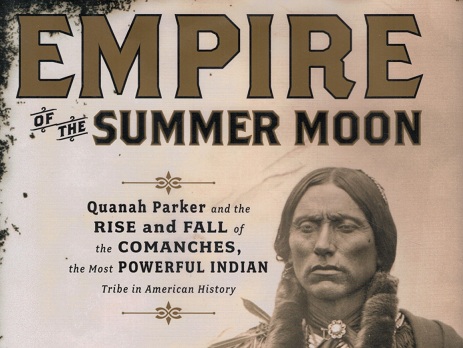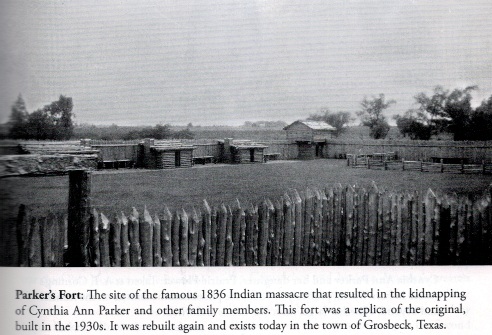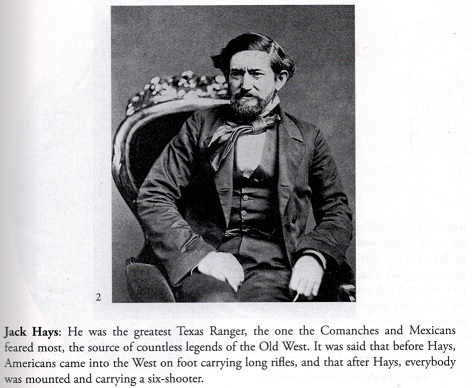Posted On: Wednesday - May 15th 2019 8:58AM MST
In Topics: History Books

Part 1 of this book review ended up with a very short discussion on the amazing horse-riding culture of the Comanche Indians of the great plains of Texas and areas to the north and west. Per the very descriptive writing of Sam Gwynne in Empire of the Summer Moon, within a century after their first acquisition by this formerly foot-bound hunter-gatherer tribe of Indians, horses were not just possessions but integral to the whole LIFESTYLE of the Comanche.
The Comanche men didn't just own small collections of different horses, as Jay Leno owns many classic cars. No, one man might have 200 of them, and a successful (at what? .. more on that in a bit.) chief might have 1,500! Boys would learn to ride at 4 or 5 years old and practice shooting from horseback soon after that. This just gives an idea of how good the men were, though even the women would ride. Shooting arrows at a rate 20 times that required for the firing of one musket round, from horseback was standard, with a 30 yard kill distance. They learned to hang on to the top of their horses, and use them as shields in battle (hey, they could get more), just as in the movies. It was everything about horses though, in which the 5 tribal bands of Comanche were best at, better than any other Indians and better than the white man. Per the author, they "were geniuses at anything to do with horses: breeding, breaking, selling and riding. They even excelled at stealing horses."
That brings up the next point though. Besides hunting buffalo for just about all their nutritional, clothing, and shelter needs, the entire culture of the tribe was about warfare. As the women did all the drudge work with the hides, cooking, packing and unpacking for moving - they were nomadic, of course - and etc., a man's job was to hunt and wage war. A man was not a warrior like a German flying ace or an American GI in Vietnam. Wars were not fought because this treaty of 1909 was abrogated ... the Commies are coming from the north ... we need more living space ... ANY OF THAT. Wars were fought because that's just what you plain did with your life. You went around looking for other tribes that were weaker and swooped in, killed men, captured some children and younger women, and stole all the horses. That was a living to them. This was the mindset of savagery. Now, no doubt, a reader could compare this to the horrors in WWI/II, and thousands of other wars fought by men of "civilized" countries. However, as horrible as things can get, in civilized society, wars are fought for some kind of reason or maybe just an excuse by some people to get other men to fight. In a savage society, the men wage war as a basic part of living, and the Comanche were about as savage as has been well-recorded.
The white man's encroachment on the Indian hunting lands, and the almost-consistent lying involved in any treaties made with the US Gov't to stop it, were indeed good excuses for war - raiding and pillaging, including torture, the usual kidnapping, and so forth. As would be expected, it had the effect of uniting some of the tribes that would have otherwise made war on each other, though some fought WITH the white man and some AGAINST him. Early on during the encroachment of the white settler into Texas, while in the eastern portion, the notorious 1836 Comanche raid on the Parker ranch/fort is well-described in this book. It's not that there weren't hundreds or even thousands of raids as terrible for the lonesome settlers as this one, but it is just very well-documented and there is the famous story of kidnapped 9-y/o Cynthia Ann Parker.

The caption mentions current-day Grosbeck, but that's not too well known either.
The location is 30-odd miles east of Waco, about 125 miles west of the Louisiana Border.
If you know Texas, that is NOT FAR into Texas!
I won't go into the gory details of this raid, but the book has plenty of that involving the fighting over 4 decades, so, that MAY be another reason to read it. Back to the stories of these amazing individuals living in that time, James Parker, patriarch of the ranch shown above, was the uncle of Cynthia Ann, but his daughter Rachael had also been taken (plenty more of the families there had been slain). The book recounts James Parker's sometimes foolhardy and sometimes lucky, search for his daughter in Indian country. It is likely the basis for the powerful 1956 John Wayne movie The Searchers, the ending of which has the same theme as the end of the search for Cynthia Ann Parker ... nope, read on, or watch the movie, I'm not spoiling it now ... ;-} The storyline of that movie is just too close the documented story of these Texas Comanche raids, that I'm sure the writer had to have learned of this history (a LOT more recent back then, 120 years rather than > 180)
Just as author Sam Gywnne did in his writing of Empire of the Summer Moon, this review is bouncing around a bit, not in time, but just from the story of the Indians themselves, the stories of the birth of Texas, and the stories of the individuals raided, raiding, or fighting what became a real war by mid-19th-century. The book has a great description of the formation (if once could call it that, as they started out as un-paid freelancers) Texas Rangers. Their purpose was to take this war to the Indians. Maybe you enjoyed the TV show, but these Texas Rangers were harder, tougher men than that Johnny Walker. The most famous was Jack Hays:

Well, if you can read Mr. Gywnne's caption, you will notice the mention of the Colt 6-shot revolver. With a nice story there too, the author describes how the tactics of riding TO the battle and then dismounting to fight had been getting the white soldiers slaughtered in a great many battles with the agile horse-bound Comanches. Trying to shoot with long rifles was too cumbersome - there were no ARs or AKs yet. The story of Jack Hay's and the Ranger's acquisition of Connecticut Yankee Sam Colt's "6-Shooter" is well-related, and that gun was as important to the white man's ability to stop the carnage of these Indians, as the horse was important to these Indians in the first place.
Part 3 will discuss the life and mindset of Cynthia Ann Parker, her son Quanah, Indian Chief and 1st actual Chief of the entire tribe throughout the conclusion of the Indian War period and the early part of the Reservation life.
Comments: